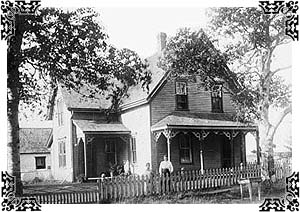







The
old expression 'A woman's work is never done' was never
more true than in the case of farm women. It is hard to
believe that were enough hours in the day for her to
finish what she had to do. In the morning, she would rise
early to prepare breakfast, which might include baking
bread, gathering eggs, and cooking porridge. After she  had the
children off to school,
things did not slow down at all. She had to look after
pressing household needs-- anything from mending clothes
to making soap-- and was also responsible for a full
share of farmyard chores. Especially during harvest
times, housework had to be taken care of after putting in
a full day in the fields. In the evening, she would
prepare a big evening meal, help her children with their
lessons, and then go to bed for well-deserved rest. That
is, until she had to get up the next morning and start
all over again.
had the
children off to school,
things did not slow down at all. She had to look after
pressing household needs-- anything from mending clothes
to making soap-- and was also responsible for a full
share of farmyard chores. Especially during harvest
times, housework had to be taken care of after putting in
a full day in the fields. In the evening, she would
prepare a big evening meal, help her children with their
lessons, and then go to bed for well-deserved rest. That
is, until she had to get up the next morning and start
all over again.
Farm women were expert dairy maids,
responsible for the refrigeration of the milk produced on
the farm. Before the arrival of electricity, keeping the
milk cool during the summer months was a real challenge.
Each farm usually had what was called a dairy, a small
outbuilding with a stone-lined cellar. Women would carry
large quantities of fresh milk to this enclosed space to
be cooled. After twelve hours, the cream would be fully
separated and they would then churn it into butter.
The job of raising the poultry often fell to the farm wife as well. But the income from egg sales was hers to manage, and provided her with a good 'nest egg' to look after household and family expenses. One local yarn tells the story of a farm wife who tried to increase her egg output by throwing the chickens oats from the back window of the granary, hoping her husband would not notice. But he soon realized what was happening. After a week, he would no more than set foot in the granary-- and suddenly every chicken on the farm was clustered at the back window.
 Farm
women were also responsible for making many of the
family's clothes, particularly the winter supply of
sweaters, mittens, and scarves. But there was more than
just knitting involved in this process, as many women
first had to prepare the wool themselves. Women would
wash, card, and spin the newly-sheared sheep wool. The
yarn was then dyed with natural substances-- such as
beets-- that lent the desired hue. Sometimes, there was
more knitting to be done than one woman could manage
herself, and she would organize a 'knitting frolic,'
where neighboring women would gather and lend a helping
hand. No one hesitated to offer her time, because the
knitting bee was also a valued social event, an
opportunity to exchange local news and even maybe a
tidbit of gossip.
Farm
women were also responsible for making many of the
family's clothes, particularly the winter supply of
sweaters, mittens, and scarves. But there was more than
just knitting involved in this process, as many women
first had to prepare the wool themselves. Women would
wash, card, and spin the newly-sheared sheep wool. The
yarn was then dyed with natural substances-- such as
beets-- that lent the desired hue. Sometimes, there was
more knitting to be done than one woman could manage
herself, and she would organize a 'knitting frolic,'
where neighboring women would gather and lend a helping
hand. No one hesitated to offer her time, because the
knitting bee was also a valued social event, an
opportunity to exchange local news and even maybe a
tidbit of gossip.
Another important role of the farm woman was
caring for the health of her family, learning how to
diagnose sicknesses and prepare tonics. Along with patent
medicines, there were countless home remedies to treat
just about any ailment, from runny noses to rheumatoid arthritis. To
ease the croup, a mother would rub goose grease and
turpentine on her child's chest and then wrap it in
flannel. Poultices were applied to fight infections, and
tonics of sulfur and molasses were administered every
spring to ward off colds during planting season. With the
warm sweaters she knit and hot meals she put on the
table, the farm woman did her best to keep the entire
family hale and hearty.
any ailment, from runny noses to rheumatoid arthritis. To
ease the croup, a mother would rub goose grease and
turpentine on her child's chest and then wrap it in
flannel. Poultices were applied to fight infections, and
tonics of sulfur and molasses were administered every
spring to ward off colds during planting season. With the
warm sweaters she knit and hot meals she put on the
table, the farm woman did her best to keep the entire
family hale and hearty.
